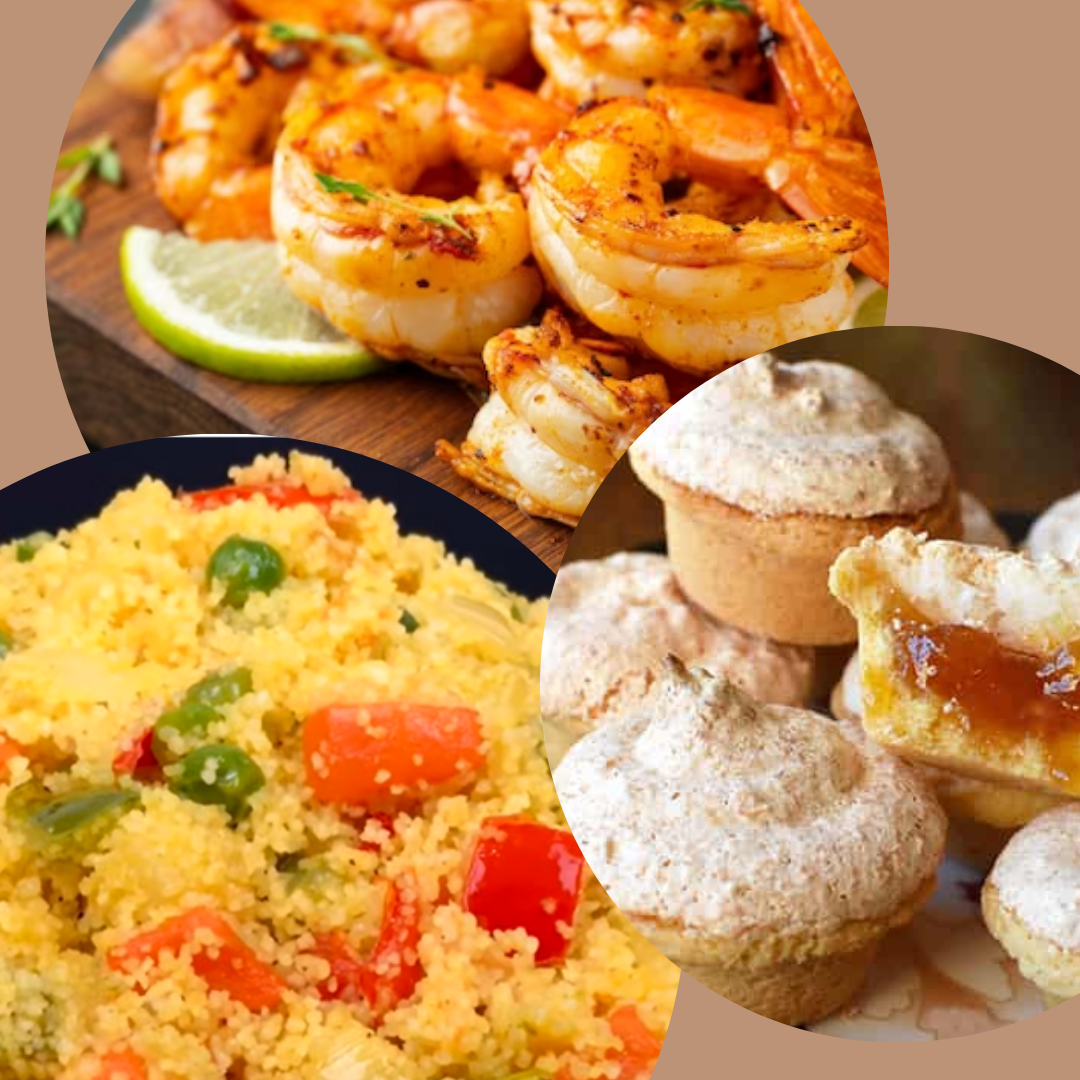Basic needs like food unite people globally, and that’s why you’ll love this full course meal from African countries. With a starter from Guinea Bissau, a main course from Mali, and a relaxing desert from Eastern and Southern Africa, you can experience countries from the comfort of your home.
Here are three recipes to help you prepare a full course meal for yourself, friends, or family.
Become an insider. Subscribe to our newsletter for more top trending stories like this!
Starter- Guinea Bissau’s Grilled Prawns
The first course is grilled prawns. Mali’s grilled prawns are a delicacy people around the world enjoy. It’s also one of the top recipes of Guinea Bissau, a country in West Africa.
Grilled prawns of Guinea Bissau are influenced by Portuguese culture, a flavorful appetizer you should have before your main menu.
Below is the step-by-step guide on how to make grilled prawns in 10 minutes.
People Also Read: Recipe: Delicious Octopus Curry of Seychelles
How to Prepare Grilled Prawns
Ingredients
- 1 lemon
- ½ tbsp of salt
- 1 large lemon
- 1 tbsp of paprika
- 4 cubes of butter
- ¼ cup of olive oil
- 1 ½ kilos of Prawns
- A handful of parsley
- ¼ cup of lemon juice
- 1 tbsp of garlic powder
- 3 cloves of garlic, minced
- ½ tbsp of cayenne pepper
- ½ tbsp of powdered pepper
Instructions
- Preheat your BBQ grill and rub some olive oil with a pastry brush
- Wash and pat dry the shrimp with a kitchen towel
- Transfer to a bowl and add the cayenne, powdered garlic, salt, paprika, and powdered pepper.
- Add the olive oil and lemon juice and mix thoroughly
- Place the prawns on the BBQ and grill for 2 minutes. Turn the prawns to the other side and grill for another 2 minutes
- Continue to turn to the other side until it’s cooked. The total cooking time should be about 8 minutes.
- Transfer the grilled prawns to a plate.
- Melt the butter in a skillet and add salt and minced garlic to make the sauce.
- Stir the sauce and squeeze the lemon into the sauce. Barbecue the lemon peels and set aside
- Take it from the fire and drizzle the mixture on the grilled prawns
- Sprinkle a handful of fresh parsley and add the barbequed lemon peels beside the grilled prawns.
- Serve with your favorite side dish like the recipe below.
Main Course – Mali’s Couscous de Timbuktu
We have couscous for the second main course. Couscous de Timbuktu is a versatile and beloved North African dish people enjoy as part of a full course meal. Its origins can be traced back centuries to North Africa.
The pasta is a product of rolled, moistened semolina from wheat. Its granules are then steamed until they are light, fluffy, and tender. The result is a delightful texture, absorbing the flavors of the ingredients you cook it with.
What Is Couscous de Timbuktu?
Couscous is a traditional food of the Maghreb region of Algeria, Tunisia, Mauritania, Morocco, and Libya. The Berbers developed it between the 11th and 13th centuries.
One aspect of this full course meal is its appeal globally. You can remarkably adapt, allowing for a wide range of recipe variations using additional ingredients. It’s a fantastic main dish that pleases almost any palate because you can add fruits, vegetables, and meats.
There are two types of couscous; this main course recipe covers the traditional type.
People Also Read: Recipe: Delicious Binyebwa | Ugandan Groundnut Sauce Recipe
How to Cook Couscous de Timbuktu
Ingredients
- 1 cup couscous
- 1 cup broth or water
- 2 tablespoons pine nuts
- 1 tablespoon fresh lemon juice
- 2 tablespoons chopped parsley
- ¾ teaspoon sea salt, more to taste
- 1 tablespoon plus 1 teaspoon extra-virgin olive oil
Instructions
- For one cup of couscous, boil 1 cup of broth or water in a saucepan. Add a small drizzle of extra virgin olive oil and a pinch of salt. Bring the water to a boil.
- Pour 2 teaspoons of olive oil into a skillet. This is an optional step but it can make a difference in imparting flavor. Add the uncooked couscous and toss around constantly, using a wooden spoon, until it’s golden brown.
- Add the golden hue pasta to the boiling water. Stir, cover the saucepan, and remove from heat or turn the heat off immediately, or leave it on slow cooker for a minute or two.
- Allow the couscous to sit undisturbed for about 10 minutes until it has absorbed all the water. Uncover and fluff with a fork. Taste and adjust the salt to your liking.
- Optionally, you can add some spices and herbs for flavor.
You can serve your couscous plain at this point. Or, feel free to add a little seasoning of your choice and some fresh herbs like ground cumin, chopped parsley, dill, and green onions. - You can add some vegetables like carrots, lettuce, onions, sweet corn, and green peas, or make a salad course with the couscous.
- Once you add the flavorings of your choice, give the couscous another toss to combine, and transfer to a serving platter. Enjoy your full course meal!
Desserts
The next course is dessert. If you’ve got a sweet tooth, you’ll love African desserts because they satisfy your craving for sweet things. The continent has a wide variety to choose from and will leave you wanting more. The good thing about some of them is you can DIY them and serve after a full course meal.
You can also order some at a restaurant near you and try them out. Some of the best African desserts include malva pudding, banana glace, and basbousa.
Below are recipes for 10 African desserts to complete your full course meal.
People Also Read: 10 of the Most Popular and Tastiest African Salads You Should Try
Mandazi (Sweet African Doughnuts)
This African dessert is popular in Kenya. Its main ingredients are:
- Flour
- Water
- Oil
- sugar
- and baking powder.
You can use additional flavors like syrups, margarine, and eggs. Once cooked, it’s a fluffy, brown pastry usually eaten as a light meal. You can also have it as a snack in the evening with tea after a hearty meal.
Also called the sweet African doughnut, Mandazi is one of the cheapest desserts you’ll come across.
Malva Pudding
Malva pudding is an African dessert popular in South Africa. The fluffy pudding draws its flavors from the:
- apricot jam
- brown sugar
- cider vinegar
- and sweet syrup.
Malva pudding is soft and moist; many people like having it with vanilla ice cream.
Moroccan Cakes (Meskouta)
This is a staple bite-sized dessert in Morocco you’ll love following a delicious full course meal. Its key ingredients are:
- Yoghurt
- Lime
- baking powder
- sugar, salt
- vegetable oil
- eggs and flour
You’ll only need to spend 45 minutes preparing Meskouta or baking it in the oven. There are different variations of the meskouta. You can add vanilla or orange for a tangy taste.
People Also Read: 11 Incredible African American Chefs Making History
Become an insider. Subscribe to our newsletter for more top trending stories like this!
Banana Glace
As the name implies, Banana Glace is a dessert made from bananas in the heart of Dakar, Senegal. It’s served with:
- few slices of banana
- heavy cream
- mashed bananas
- and sugar.
Garnish the banana glace with nuts and fruits like red cherries, black raisins, and peanuts. You can accompany this creamy dessert with a cup of coffee.
Akwadu
Akwadu is an African dessert from Equatorial Guinea. Its main ingredients are:
- Bananas
- orange juice
- lemon juice
- brown sugar
- and grated coconut.
The bananas are baked for a few minutes. If you don’t have bananas, you can use plantains. You can eat the dessert over breakfast or dinner.
Join our Spotcovery Global Black Community Facebook Group for early access to exclusive content and to share in a lively discussion.
Makroud El Louse (Algerian Almond Cookies)
These cookies contain:
- Sugar
- Eggs
- orange flower water
- and almonds.
When you cook, makroud el louse becomes light brown. You can then toss and coat them in powdered sugar. Serve the cookies with a cup of tea or coffee.
People Also Read: Recipe. A Taste of Niger’s Culinary Traditional Djerma Stew
Sonhos De Banana
Sonhos De banana is an African dessert that originates from Sao Tome and Principe. The Portuguese influenced it. This dessert is made of:
- mashed bananas mixed with baking powder,
- Cinnamon
- Sugar
- flour
- and eggs.
When serving, dust them with cinnamon sugar.
Basbousa
Basbousa, or semolina cake, is an Egyptian dessert. Its ingredients are
- Sugar
- Yogurt
- semolina
- and coconut.
To prepare it, mix the semolina and sugar, add yogurt to the melted butter, and cook for 30 to 45 minutes. Due to the high sweetness levels in the dessert, serve it with a non-sugary drink.
People Also Read: Recipe. How to Prepare Authentic Angolan Muamba de Galinha
Hertzoggies
Known as the South African jam and coconut tartlets, this African dessert consists of
- apricot jam
- a soft crust and sweet coconut
They are so delicious that if you don’t keep yourself under control, you might find it hard to stop eating them. These lovely treats are served with tea.
Coconut Rice Pancakes (Vitumbua)
Vitumbua is a common delicacy in East Africa. These niceties are eaten for breakfast but can be used during evening tea or as a snack. You’ll need the ingredients below to make Vitumbua.
- Rice
- sugar
- coconut milk
- Yeast
- Salt
- cooking oil
- and cardamon
When well-prepared they turn out fluffy and crunchy.
You should spice up your meals with these African full course meal recipes if you’re tired of eating the same routine of dishes. With these recipes, you’re off to a good start for a full course dinner!
Serving Tips for a Full Course Meal
- For the couscous, you can add bits of chicken or cubes of fried red meat, and turkey for your taste buds.
- You can also serve your grilled prawn over ground scotch bonnets and tomatoes for a spicy feel or serve it with white wine or red wine.
Nearly 80% of consumers visit directories with reviews to find a local business. List your business for free in our exclusive Spotcovery Black-Owned Business Directory.
Spotcovery offers unique and fresh daily content on Black culture, lifestyle, and experiences. We talk about everything black, black people, black-owned and black-owned businesses. We also deliver authentic and relevant content that will inform, inspire and empower you! The future of black media is critical to today’s black experience! Our primary audience includes African American, African, Afro-Caribbean, and people of African heritage. Black culture is for the culture!
Become an insider. Subscribe to our newsletter for more top trending stories like this!





